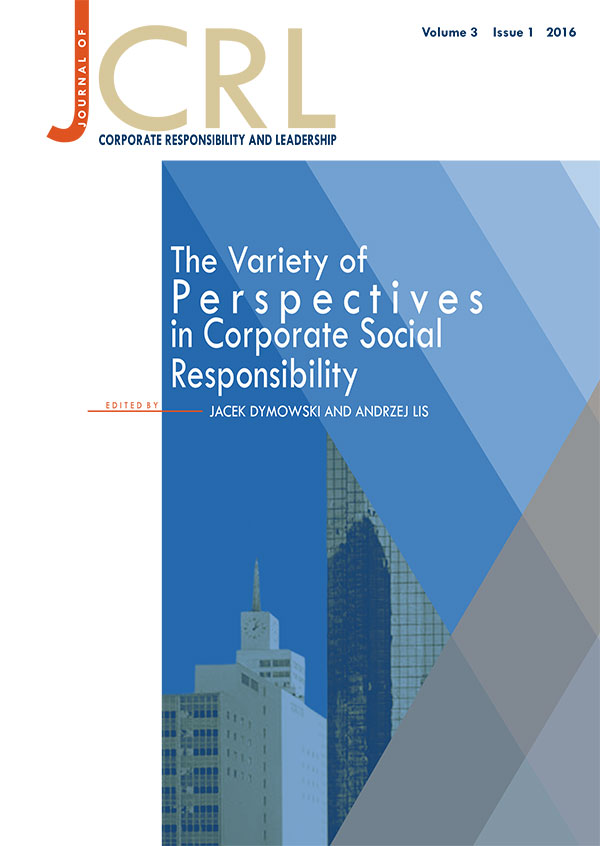Diversity Management as a Responsible Way of Searching for Job Candidates – Case Study of Big Companies that Signed Diversity Chart in Poland
DOI:
https://doi.org/10.12775/JCRL.2016.002Abstract
The aim of the paper is to analyse the usage of diversity management in the recruitment process in companies operating in Poland, which signed D iversity Charter (DC) document. The main emphasis is put on three most important aspects of diversity: gender, age and disability, as they are the leading barriers for hiring employees in Poland. I n order to achieve this goal, the following objectives has been set: (1) to identify elements of job offers that are opened for diversity, (2) to analyse job offers of big companies which signed D C in terms of using the elements opened for diversity (3) to discuss diversity management issues in the recruitment process of Polish companies. The case study analysis is a research method applied in the paper. The investigation is based on the content of job offers to be found in different platforms designed for recruitment as well as on the companies’ websites and the opinions of experts expressed in non-standardized interviews. The results of the research indicate that the majority of companies follow with the principles of diversity management, as they have declared. However, many of them should improve their communication related to diversity issues. I t is worth emphasizing that companies should more carefully create descriptions of job offers. What is more, there is much to be done in the context of caring for people with disabilities during recruitment.
References
Barak, M.E.M. (2012), Managing Diversity: Toward a Globally Inclusive Workplace, Sage Publications Inc., Thousand Oaks.
Bodzhansky, T. (1979), Różnorodność i równość, Państwowy I nstytut Wydawniczy, Warszawa.
CSO (2015), Yearbook of Labour Statistics, Central Statistical O ffice, Warsaw. Retrieved from: http://stat.gov.pl/download/gfx/portalinformacyjny/pl/defaultaktualnosci/ 5515/7/4/1/publik.pdf (accessed 4 July 2016).
Diversity Charter in Poland (nd). Retrieved from: http://kartaroznorodnosci.pl/pl/kartaw- polsce/sygnatariusze.html (accessed 29 August 2015).
Ephraim, A., Melvin, C. (2012), “Workforce D iversity and O rganizational Communication: Analysis of Human Capital Performance And Productivity”, Journal of Diversity Management, Vol. 7, No. 1, pp. 57 – 61.
European Commission Justice (2012), Managing Diversity at Work: Realising the Business Benefits with European Diversity Charters, Publication O ffice of the European Union, Luxembourg. Retrieved from: http://ec.europa.eu/justice/discrimination/files/ managing_diversity_atwork_en.pdf (accessed 19 March 2016).
Eurostat (2014), Europe 2020 Employment Indicators. Retrieved from: http:// ec.europa.eu/eurostat/documents/2995521/6823708/3 – 07052015-AP-EN. pdf/7e507ea0 – 43c7 – 452f-8e6a-b479c89d2bd6 (accessed 04 July 2016).
Eurostat (2015), Employment and Activity by Sex and Age – Annual Data. Retrieved from: http://ec.europa.eu/eurostat/en/web/products-datasets/-/LFSI_EMP_A (accessed 04 July 2016). Forum O dpowiedzialnego Biznesu (2009), Firma = różnorodność, Vol. 2, Warszawa. Retrieved from: http://odpowiedzialnybiznes.pl/public/files/firma_roznorodnosc. pdf (accessed 19 March 2016).
Forum O dpowiedzialnego Biznesu (2013), Łączy nas różnorodność: Przewodnik po Karcie Różnorodności, Warszawa. Retrieved from: http://odpowiedzialnybiznes.pl/ public/files/Forum_Odpowiedzialnego_Biznesu_Laczy_nas_roznorodnosc_Przewodnik_ po_Karcie_Roznorodnosci_2013.pdf (accessed 19 March 2016).
Hajec, M. (2016), Wynagrodzenia kobiet i mężczyzn w 2015 roku. Retrieved from: http://wynagrodzenia.pl/artykul/wynagrodzenia-kobiet-i-mezczyzn-w-2015-roku (accessed 04 July 2016).
Hunt, V., Layton, D ., Prince, S. (2014), Diversity Matters, McKinsey&Company, New York. Retrieved from: https://web.duke.edu/equity/toolkit/documents/Diversity- Matters.pdf (accessed 19 March 2016).
Król, H., Ludwiczyński, H. (2006), Zarządzanie zasobami ludzkimi: Tworzenie kapitału ludzkiego organizacji, Wydawnictwo Naukowe PWN, Warszawa.
Lisowska, E., Sznajder, A. (2014), Zarządzanie różnorodnością w miejscu pracy: Raport z II edycji Barometru Różnorodności, Konfederacja Lewiatan, Warszawa. Retrieved from: https://issuu.com/pkpplewiatan/docs/ii_barometr_raport (accessed 19 March 2016).
Loden, M. (1996), Implementing Diversity, McGraw-Hill Companies, Burr Ridge, IL.
Oleksyn, T. (2014), Zarządzanie zasobami ludzkimi w organizacji, O ficyna a Wolters Kluwer business, Warszawa.
Olszowska, K. (2014), “Zatrudnianie osób niepełnosprawnych – co zyskują pracodawcy?” Retrieved from: http://www.rynekpracy.pl/artykul.php/wpis.822 (accessed 04 July 2016).
PwC (2015), Diversity Adds Millions to the ISS Bottom Line. Retrieved from: http:// odpowiedzialnybiznes.pl/wp-content/uploads/2015/04/Diversity-adds-millions-tothe- ISS-bottom-line_report.pdf (accessed 19 March 2016).
Rydzewska, K. (2014), “Rekrutacja otwarta na rożnorodność”, in: Kompendium HR, Grupa Pracuj S.A., Warszawa, pp. 92 – 93.
Saxena, A. (2014), “Workforce D iversity: A Key to I mprove Productivity”, Procedia Economics and Finance, Vol. 11, pp. 76 – 85.
Sznajder, A. (2013), Przewodnik po zarządzaniu różnorodnością, Konfederacja Lewiatan, Warszawa.
The Economist I ntelligence Unit (2014), Values-based Diversity: The Challenges and Strengths of Many. Retrieved from: http://www.economistinsights.com/sites/default/ files/EIU_SuccessFactors_Values-based%20diversity%20report.pdf (accessed 19 March 2016).
Walczak, W. (2011), “Zarządzanie rożnorodnością jako podstawa budowania potencjału kapitału ludzkiego organizacji”, E-mentor, No. 3 (40), pp. 11 – 19.
Wojnicki, S. (2014), “Zarządzanie pracownikami 50+ wyzwaniem dla firm”, Personel i Zarządzanie, No. 6 (291), pp. 40 – 44.
Wojsławowicz, E. (2014), “Zarządzanie różnorodnością – prawo i praktyka”, Analiza tematyczna Forum Odpowiedzialnego Biznesu, No. 1, Retrieved from: http: //odpowiedzialnybiznes.pl/wp-content/uploads/2014/04/Analiza-tematyczna _Zarz%C4%85dzanie-r%C3%B3%C5%BCnorodno%C5%9Bci%C4%85-%E2% 80%93-prawo-i-praktyka-.pdf (accessed 19 March 2016).
Downloads
Published
How to Cite
Issue
Section
Stats
Number of views and downloads: 349
Number of citations: 0



